We understand you want to provide your aquatic pet the care it deserves. However, knowing all your pet’s needs can be quite challenging. But we are here to help you with that. Today we will discuss all you need to know about the Green Spotted Puffer.
You might be wondering: How to keep my green puffer healthy? How big do they grow? What kind of tank mates are best? but before answering all these questions, here’s what we will cover today.
In this comprehensive guide, we will discover the Green Spotted Puffer’s natural habitat. This way you can mimic its native environment so the fish feels at home. Moreover, we will discuss its appearance and Tank details. Additionally, we will also explore its breeding and common diseases.
Here’s a Quick Guide for you Green Spotted Puffer
| Minimum Tank Size | 30 gallons |
| Tank Temperature | between 78°F and 82°F |
| Tank mates | Larger fish |
| Lifespan | 10 to 15 years |
| Adult Size | 6.7 inches |
| Diet | Primarily carnivorous |
Origin
The Green Spotted Puffer originates from freshwater rivers, lakes, and brackish coastal areas. It is specifically found in countries like India, Sri Lanka, Myanmar, and Thailand. This fish has an adaptive nature as it thrives in freshwater, brackish waters. It can even survive in saltwater as an adult. This fish is commonly referred to as the brackish water puffer or brackish puffer because of its adaptability to brackish water.
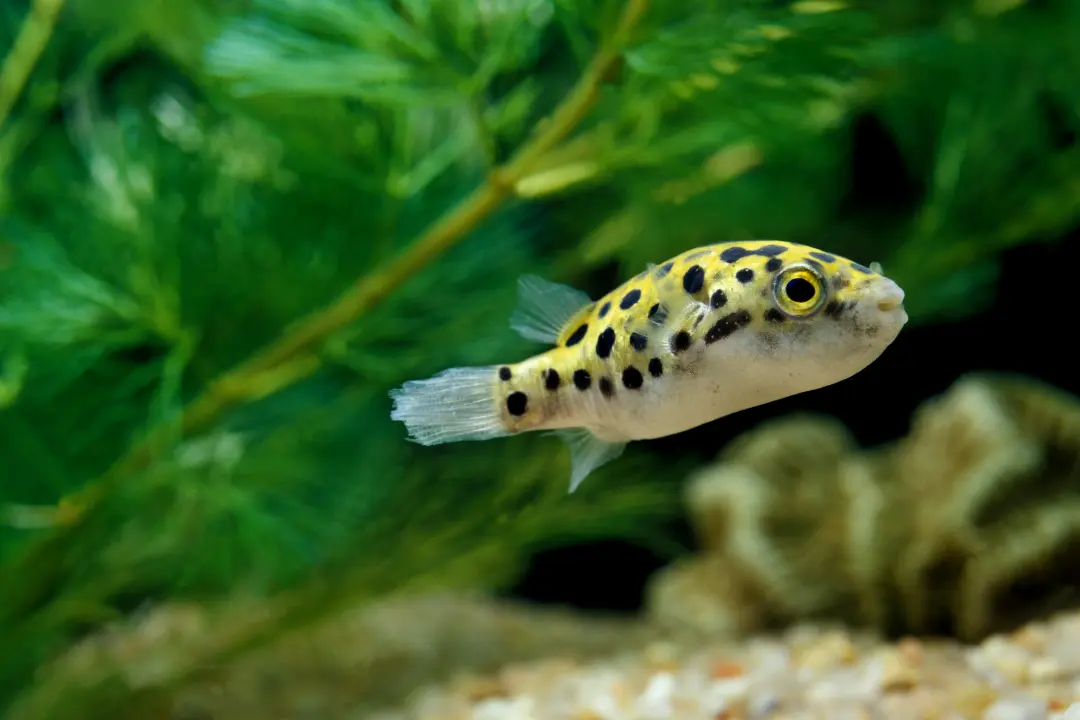
Green spotted Puffer Appearance
The Green Spotted Puffer has a round body with a greenish color. The upper body is green while the lower body has a yellow or white hue. The green part is adorned with black dots that give it a unique spotted look. The males have a more intense coloration as compared to their counterparts
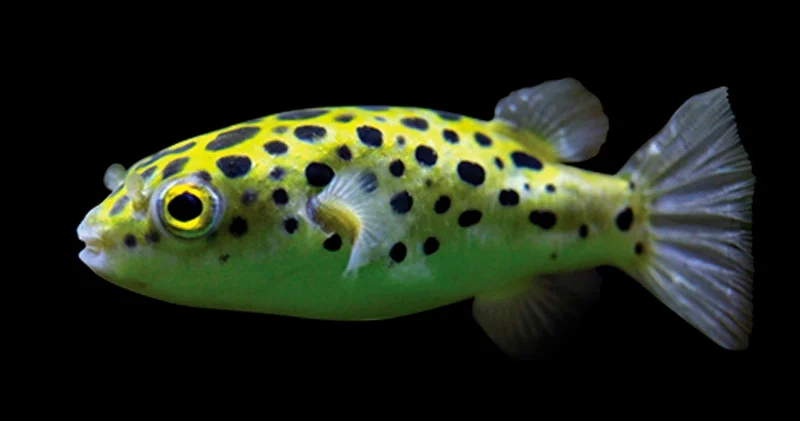
In addition, this fish has large expressive eyes. Along with that, this fish can inflate itself by gulping air or water when it senses a threat. Both the large eyes and the inflated body make an intimidating look to scare off predators. But it isn’t that big and scary! The Green Spotted Puffer has big lips that appear as if the fish is smiling.
Lastly, the Green Spotted Puffer has a fan-shaped tail fin while other fins are relatively small. Generally, these smaller pectoral and anal fins are transparent. These fins work with the tailfin and mimic a flapping motion that allows the fish to ascend and descend in the water levels.
Green Spotted Puffer Size
The Green Spotted Puffer is a medium-sized fish. Typically, an adult Green Spotted Puffer grows up to 6 inches in length but in optimal environments, it might grow slightly more. Here’s a complete detail on its size.
Male vs Female
Green Spotted Puffers have sexual dimorphism. This means that the males and females are almost identical. However, they do have small differences that tell them apart. The males and females reach up to 6 inches, but the females grow slightly larger than the males.
In addition, the females usually have a round body while the males are more streamlined.
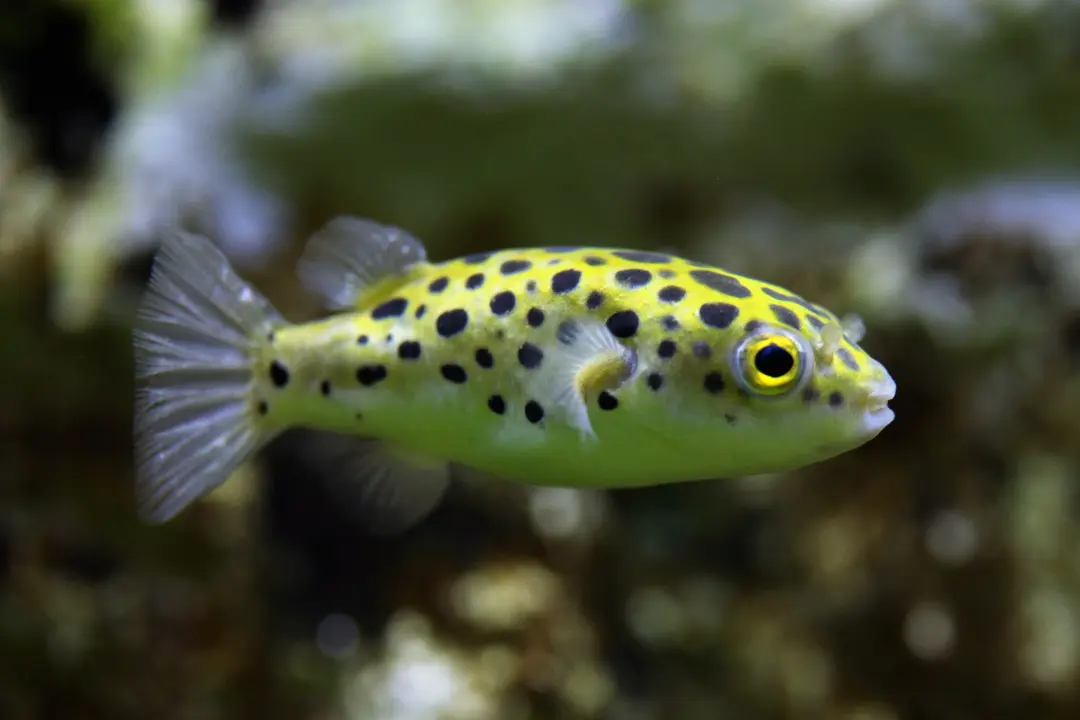
Green spotted Puffer Life Span
The Green Spotted puffer has a long lifespan of about 10 to 15 years, in captivity. However, it’s important to provide it with proper care to achieve this long life. You need to consider many factors such as water quality, tank size, and water parameters.
To ensure a long lifespan, maintain a brackish water tank. Moreover, the water salinity must mimic its natural habitat. You must also change the water regularly to maintain low ammonia and nitrite levels.
Proper diet and tank mates must be provided as well. For more dedicated care, follow the tips in this article
Green Spotted Puffer Behavior
The Green Spotted Puffer has a curious and active nature. It likes exploring its tank and new hiding spots. In addition, it is well known to be an intelligent fish that can recognize its owner.
Although this fish is very playful, it has a reputation for aggression. This fish is highly territorial and hostile towards other fish. So, it’s best to keep this fish in a separate tank.
However, consider larger fish if you still want to add some tankmates for a more lively aquarium. The Green Spotted Puffer tends to nip tankmate’s fins, so make sure the tankmates can manage.
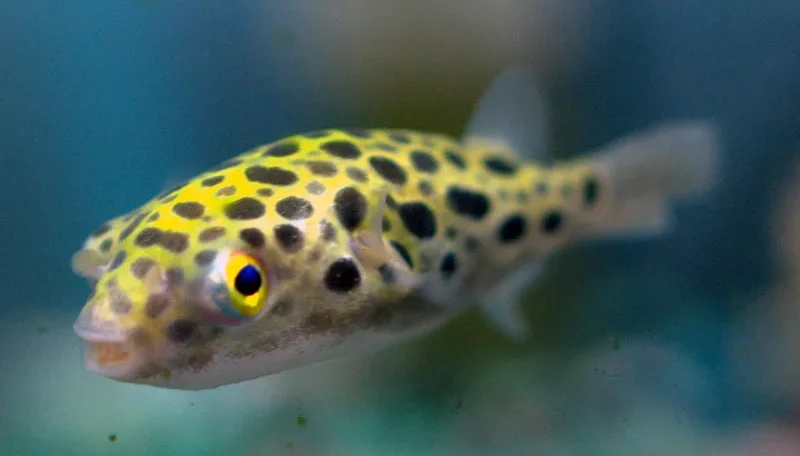
To manage aggression, ensure you have ample space and a lot of hiding spots in the fish tank. If you notice any aggression, separate the fish as soon as possible.
Green Spotted Puffer Tankmates
You’re in for a challenge if you’re about to choose tankmates for the Green Spotted Puffer. This fish has a nipping and hostile behavior towards tankmates. Moreover, this behavior is intensified in smaller tanks. Therefore, you should choose tankmates that can bear some stress and bullying.
It’s best to have larger tankmates than the Green Spotted Puffer. Additionally, they should be fast-swimming fish that can tolerate some fin nipping. Here are some of the best tankmates for a Green Spotted Puffer.
- Mollies
- Archerfish
- Monos
- Bumblebee Gobies
- Scats
- Knight Gobies
- Sailfin Mollies
- Glassfish
- Flagfish
- Indian Mudskipper
It’s important to provide the ideal environment for all the fish in the tank. Your tank must have enough space and hiding spaces to disrupt any aggression. Use plants, rocks, and small caves to make territories for the fish.
Green Spotted Puffer Fish Tank Setup
Green Spotted Puffer needs a specific tank environment as it belongs to brackish waters. This means that their natural habitat has a mix of freshwater and saltwater. Here are some tips for setting up a tank for Green Spotted Puffer.
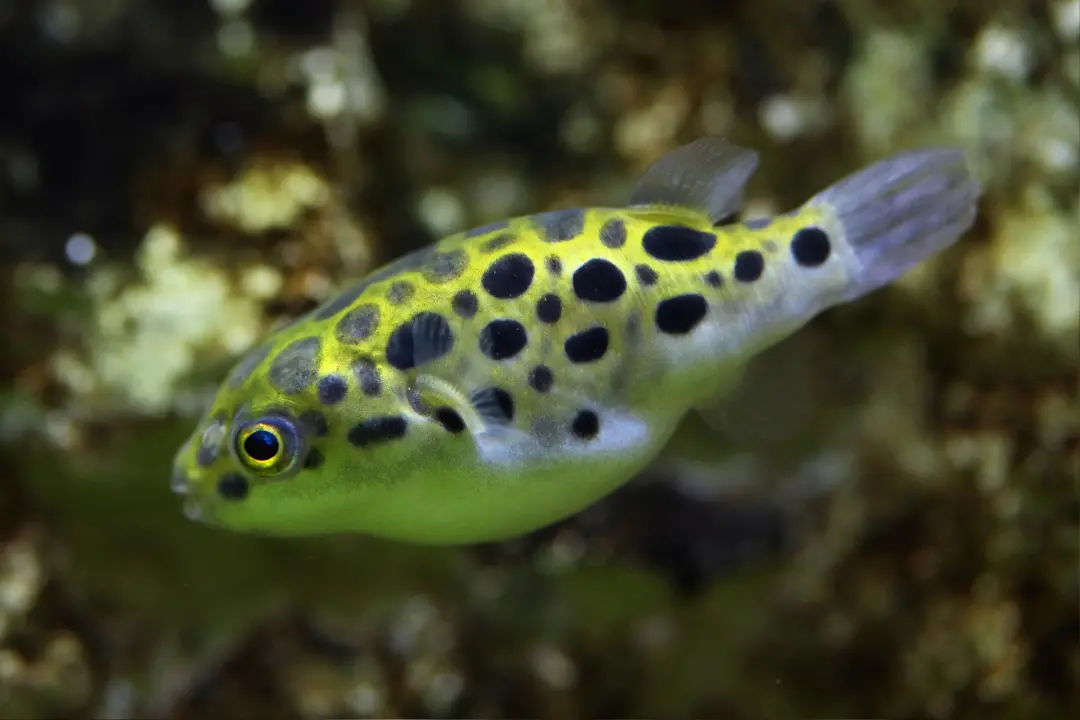
Tank Size
As we know, the Green Spotted puffer has an aggressive nature. Moreover, it has a slightly larger size than most small fish. So, it naturally requires more space to thrive in a tank. And if you’re adding tankmates, you need to add extra space to reduce aggression.
At least a 30 gallon tank is necessary for the Green Spotted fish to flourish in captivity. Add 10 gallons of space for each tankmate.
Tank Water Parameters
As discussed above, this fish thrives in brackish water. You should have tank water with a salinity level of 1.005 to 1.008. Moreover, maintain a pH level between 7.5 to 8.5. Keep the water temperature between 78°F and 82°F. The water hardiness must be between 8 to 12 dGH.
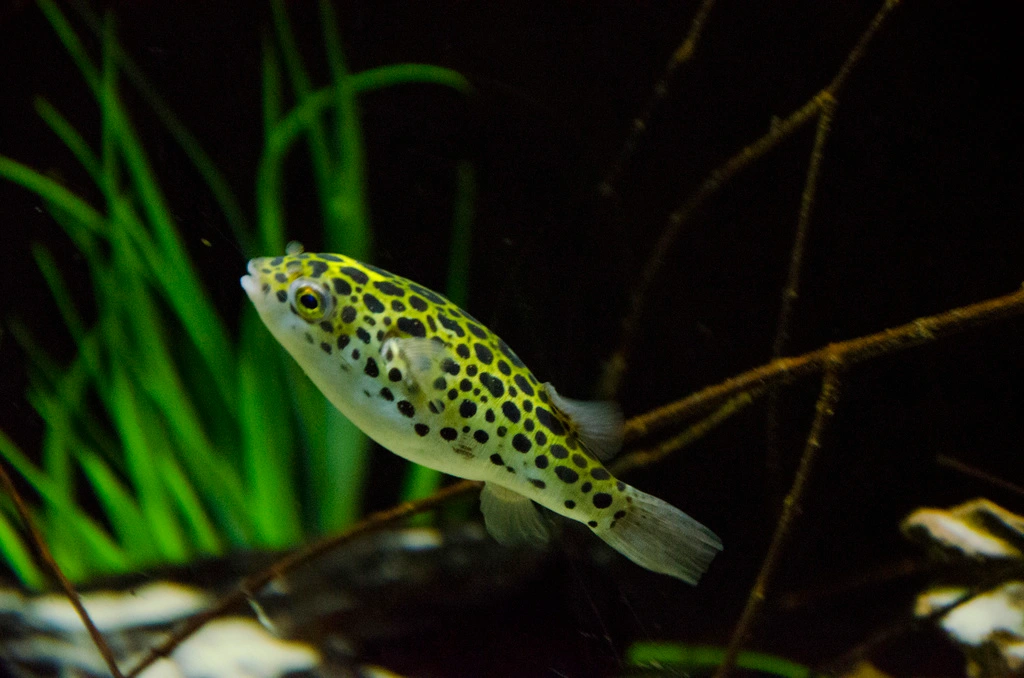
Talking about toxins, the ammonia and Nitrite levels should be strictly 0 ppm as this fish is very sensitive to toxins. However, you can keep the nitrate level below 20 ppm.
The Green Spotted Puffers are messy eaters, so use a good quality water filter to keep the tank clean. Moreover, change about 30 percent water every week. The tank should be well aerated as well.
Tank Substrate and Decor
Mimic the fish’s habitat by adding many plants and hiding spots in the tank. Use plants Java fern and Anubias, as they can tolerate brackish water. Use rocks and caves to reduce stress in the tank. Lastly, use a smooth substrate that includes no sharp or hard objects that could injure the fish.
Green Spotted Puffer Acclimation
Acclimating a Green Spotted Puffer to a new tank is extremely important. You can’t just add this fish to a new tank! As this fish is sensitive to water conditions, you need to follow a careful process to introduce it to a new tank. Here is a step-by-step guide.
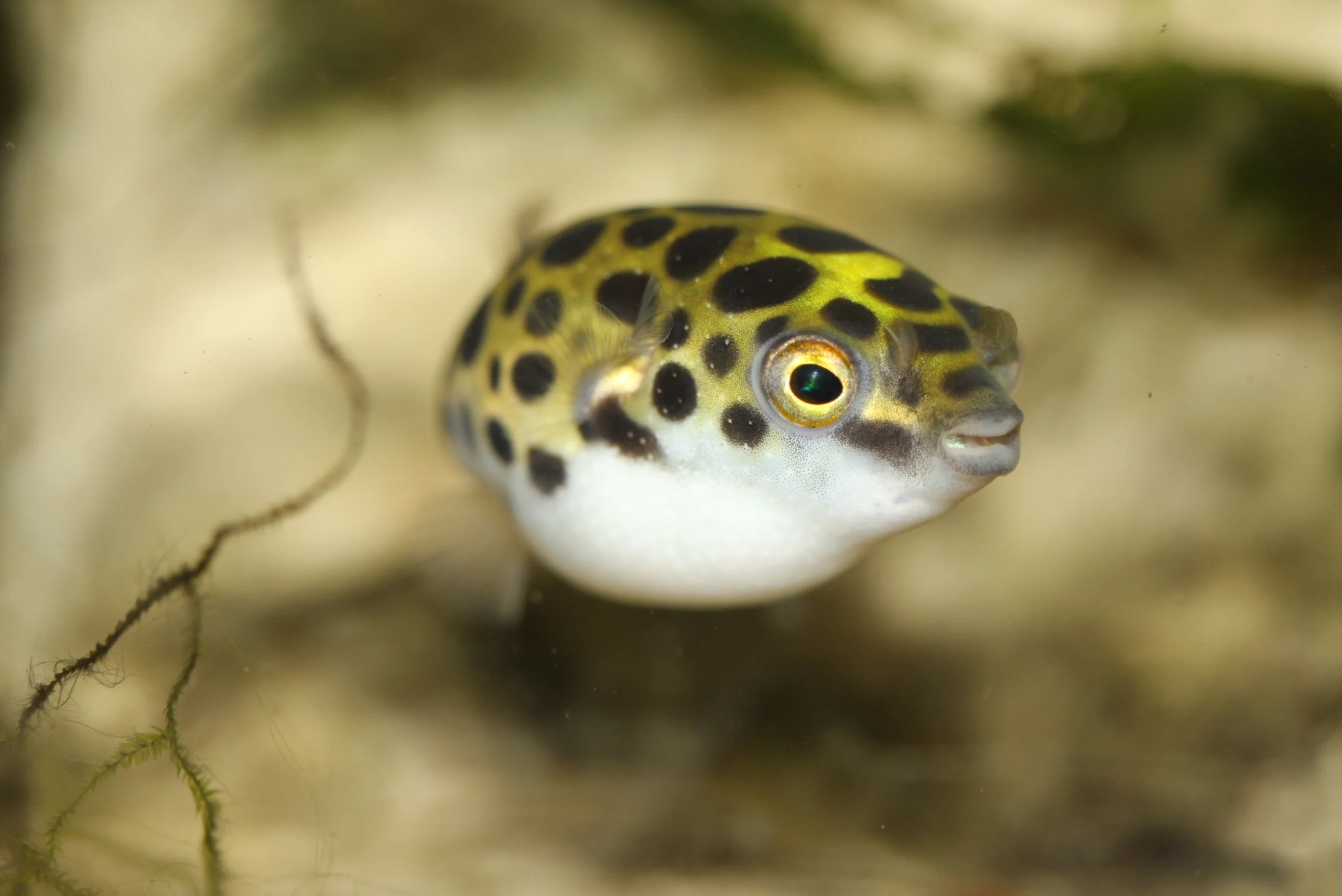
- Your fish must be in the sealed bag in which you bought it, begin floating this bag in the tank for about 15-20 minutes. This will equalize the temperature, reducing shock.
- Next, secure the bag with the tank wall. Add a small amount of tank water to the bag every 10 minutes for an hour. This will adjust pH, salinity, and other parameters
- After an hour, gently release the fish into the tank but be gentle. Don’t add the bag water to the tank as it may contaminate the tank.
Monitor the fish for the next few days for any stress, illness, or erratic swimming patterns. If none are seen, you’re good to go! Otherwise, check the salinity level and align the tank parameters. Maintain a healthy diet and check for disease.
Green Spotted Puffer Diet
The Green Spotted Puffer is primarily carnivorous however, it occasionally eats some veggies. In the wild, it feeds on invertebrates, crustaceans, and small fish. But in captivity, they feed on a varied diet that mimics their natural food. Here are some of the best foods for Green Spotted Puffer.
- Hikari Bio-Pure Freeze-Dried Bloodworms
- Zoo Med Can O’ Snails
- San Francisco Bay Brand Freeze Dried Brine Shrimp
- Omega One Freeze-Dried Krill
- Omega One Freeze-Dried Mysis Shrimp
Primarily its diet includes live or frozen bloodworms, brine shrimp, and blackworms. Additionally, you should add snails and small crabs to their diet. The Green Spotted Puffer has continuously growing teeth. So, these hard foods are needed to trim these teeth regularly.
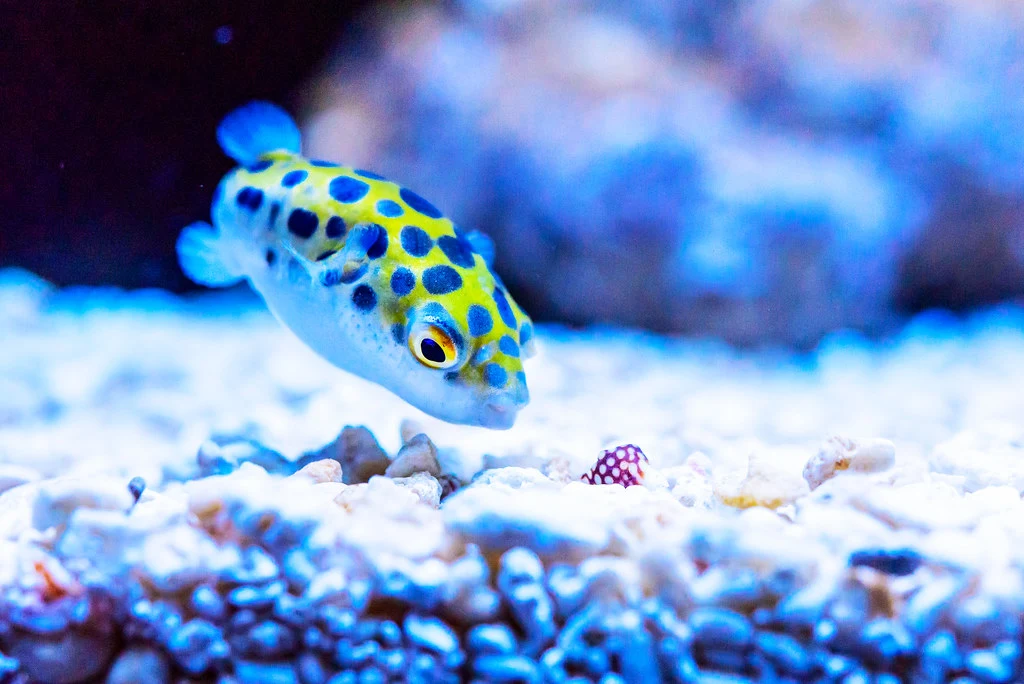
Moreover, you should add some live foods as they satisfy the Puffer’s hunting nature. A varied diet is the best food for green spotted puffer fish so explore some combos. Supplement its diet with carnivorous fish pellets but add high-protein foods too. Remember, pellets are only supplements for this fish, not alternatives.
Feeding routine
It’s important to feed the fish with the appropriate amount of food. Overfeeding or underfeeding can cause major health issues. Only provide enough food that the fish can finish within a few minutes.
Pro Tip: This fish is already a messy eater, add food sparingly so you don’t create a mess or contaminate the tank
Young Puffers must be fed twice a day while Adults should be fed only once daily. Remove any uneaten food. Providing a mix of foods prevents nutritional deficiencies.
Common Diseases
Green Spotted Puffers have a unique physiology making them prone to many diseases. As an owner, you should know about the most common ones to avoid them as soon as possible. Here are the most common diseases along with their symptoms.
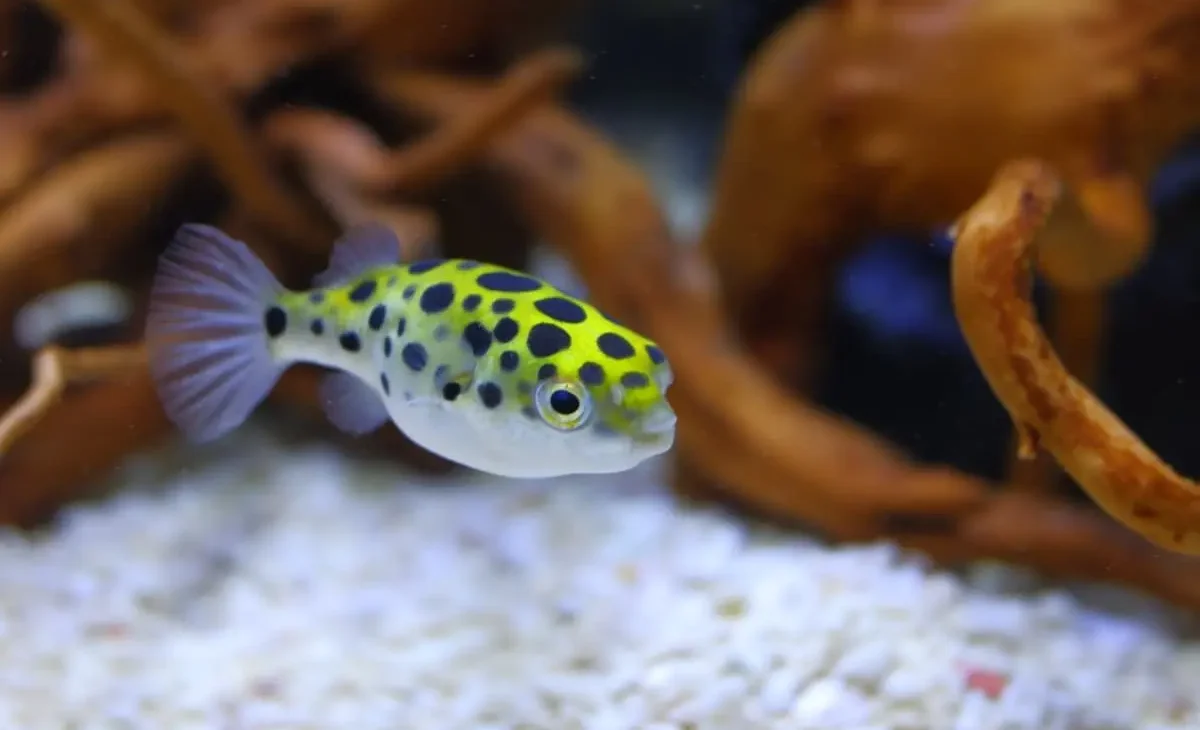
Marine Velvet
Marine Velvet is a parasitic disease that is very common in Green Spotted Puffers. This disease can be deadly for the fish if not treated early. Here are its symptoms along with possible cures
Symptoms
- Golden or Rusty Appearance: The affected fish might be covered with a golden or rusty sheen.
- Rapid Breathing: The fish can’t breathe properly. due to gill damage. So, you might see it struggling to breathe.
- Lethargy: The affected fish will become less active and lose appetite.
- Rubbing and Scratching: The affected fish will scratch against tank walls and objects. This relieves pain and irritation.
- Cloudy Eyes and Fins: If the parasite has advanced, you might see clouded or deteriorated fins and eyes.
Cure
- Quarantine: As this is a parasitic issue, it can spread like wildfire. It’s best to keep the affected fish in a separate tank.
- Medications: Use copper-based medications like copper sulfate, which are effective against parasites. However, before using any medicine, always consult a professional.
- Freshwater Dips: Briefly dip the fish in freshwater for 3 to 5 minutes. This might help dislodge some parasites from the fish’s body.
- Increase Water Temperature: Increasing the water temperature will speed up the parasite’s lifecycle. Crank the temperature up to 82 degrees Fahrenheit.
- Maintain Water Quality: Ensure the water quality and parameters are pristine. Change the water regularly for a quick healing process.
If the fish doesn’t show a positive response to this treatment, it’s best to consult a professional.
Ich
Ich, or white spot disease is also very common in Green Spotted Puffers. This disease is caused by a protozoan parasite that can be fatal if not treated promptly. Here are its symptoms along with possible cures:
Symptoms
- White Cysts: The affected fish will have white spots on its body. These are actually the parasitic cysts that cause the disease
- Rapid Breathing: The gills will get damaged and the fish will have difficulty breathing. So, you might see it struggling and breathing rapidly.
- Clamped Fins: The fish will clamp its fins and lose its vibrant look. The fins will get ragged as if someone tore them apart.
- Lethargy: The infected fish will be inactive and will lose its appetite.
- Rubbing and Scratching: Just like the Marine Velvet, the fish will rub on tank walls and objects. This relieves the fish from pain and irritation.
Cure
- Quarantine: It’s best to quarantine the affected fish in a separate tank. Just like the Marine velvet disease, the ich is highly contagious. So, tankmates are not safe. If one fish is affected, you can say that all the fish in the tank are affected.
- Increase Water Temperature: Increased water temperature speeds up the parasite’s life cycle. This way you can get a quicker recovery.
- Maintain Water Quality: Check all the water parameters and keep the tank clean. Regularly change the tank water to dispose of the contaminated water.
Here’s a more detailed guide to fish Ick disease.
Breeding Green Spotted Puffer
Breeding Green Spotted Puffers in captivity is quite a challenge. These fish need a specific environment for breeding which can be hard to mimic. Here’s a step-by-step guide to breed Green Spotted Puffers.

Use a spacious water tank with many hiding spots. Add flat rocks and plants to mimic its natural habitat. The water parameters must be ideal, as mentioned earlier. The size of the tank matters a lot as a full grown Green Spotted needs its space.
After the tank is set, choose a healthy pair. Make sure they have different genders as it can be quite confusing. Look out for any abnormalities, like discoloration or injury. Remember, the fish must be physically fit.
Puffers lay eggs on flat surfaces. Make sure you have some smooth flat spaces in the tank for the fish to spawn. As soon as the fish lays eggs, you should take the fish out of the tank. This will ensure the egg’s safety as Puffers are known as egg-eaters.
Now, you need to perform regular water changes and maintain water quality. The eggs usually hatch in a week. ensure the water pH and all parameters are ideal for their survival.
Once the eggs hatch, feed them microscopic food like infusoria. Newly hatched brine shrimp is also good for developing fry. Gradually introduce larger foods as the fry grows. Maintain water quality for increasing chances of survival.
This is a general method for Breeding Puffers. Breeding the Green Spotted Puffers in captivity is not very common. Additionally, there are almost no reports of successfully breeding this fish, except one from the University of Florida in 2009. This fish is usually caught or bred in special aquaculture facilities.
FAQ’s
What do green spotted pufferfish eat?
Green Spotted Puffer is primarily a carnivorous. Small crabs, blackworms, and other meaty foods are ideal for this fish. For more Green Spotted Puffer foods, check out the links given above.
What fish can live with green spotted puffers?
Fast swimming fish that can tolerate some aggression are best for Green Spotted Puffers. Mollies, monos, and scats are some good options.
How big of a tank does a Green Spotted Puffer need?
We suggest at least a 30 gallon tank for a Green Spotted Puffer. However, the bigger the Better. Make sure the fish has free space to explore and maintain its territory.
Conclusion
In conclusion, this was all about the Green Spotted Puffer Care Guide. In today’s article, we discussed the Origin and appearance of this amazing fish. Moreover, we explored its behavior and possible tankmates. We also discussed how to set up the ideal tank for a green puffer.
In addition, we have discussed the best foods for Green Spotted Puffer and its feeding routine. We also added some potential health issues the fish can experience in captivity.
Pro Tip: No matter what fish you have, Proper tank setup is key. Always make sure that the tank mimics the fish’s natural habitat. Keep a clean environment by maintaining water Quality to ensure your pet’s well-being.
Let us know what you think about this article in the comments below. We love to hear your thoughts and feedback!
